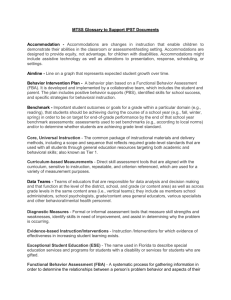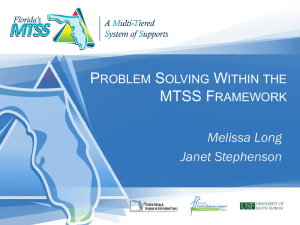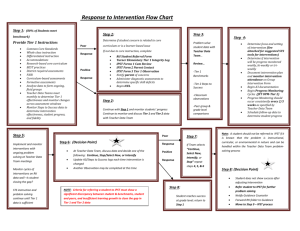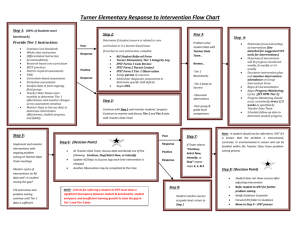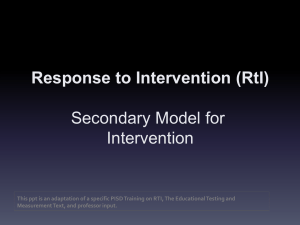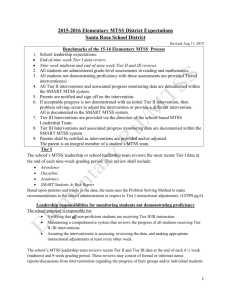MTSS Contacts Presentation 12.2.13
advertisement
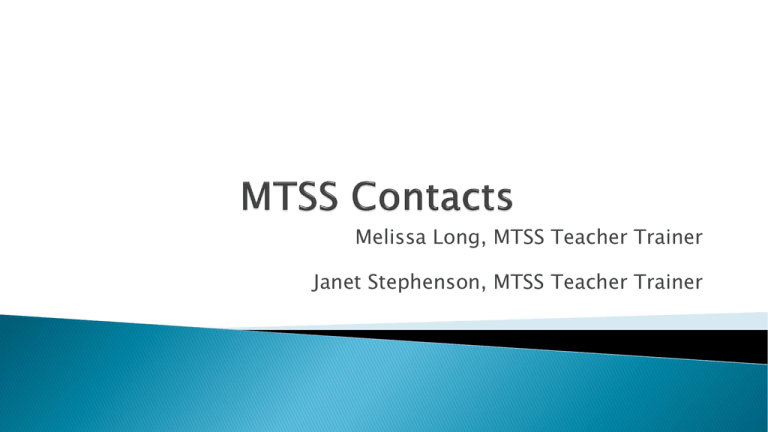
Melissa Long, MTSS Teacher Trainer Janet Stephenson, MTSS Teacher Trainer What do we want you to Know? The essential components to an effective MTSS system What do we want you to Understand? Structures that need to be in place to assist in the success What do we want you to be Able to do? Share your knowledge at your school Create an action plan Problem Solve using the IPST forms Agenda 1. 2. 3. 4. 5. 6. Welcome and Introductions Where are you now? Problem Solving -Developing your School’s Infrastructure Meetings – Data Teams & IPST Data Based Decision Making Building your knowledge How can you help strengthen the infrastructure for MTSS at your school? Take a minute to self-assess the MTSS process in your building. Condition 1 Underachievement in: Oral expression Listening comprehension Written expression Basic reading skills Reading fluency skills Reading comprehension Mathematics Calculation Mathematics problem-solving Condition 2 + RTI: Resource intensive or insufficient response to scientific, research-based intervention Condition 3 + Conditions 1 and 2 not primarily the result of: Visual, hearing or motor disability Intellectual disability Emotional/Behavioral disability Cultural factors Irregular attendance Environmental or economic disadvantage Classroom behavior Limited English proficiency 7 1. Tiers of Intervention: Students who do not respond to high-quality classroom instruction (Tier 1) and intervention (Tier 2) receive more intensive, individualized research-based interventions (Tier 3). Tiers are the level of intensity of the intervention. 2. Progress Monitoring: Data-based documentation of repeated assessments reflecting student progress. 3. Data Based Decision Making: Students who don’t respond to these interventions or require a highly individualized program to progress are evaluated in a more comprehensive manner. ACADEMIC and BEHAVIOR SYSTEMS Tier 3: Intensive, Individualized Interventions & Supports. Tier 2: Targeted, Supplemental Interventions & Supports. Tier 1: Core, Universal Instruction & Supports. Tiered System of Intervention RtI Systematic Problem Solving Data Monitoring and Analysis Turn and Talk ◦ Talk to a partner about which of the three cornerstones you feel is going well at your school ◦ Capacity to Problem-Solve ◦ Capacity to Collect Data, and Make Sense of It ◦ Capacity to Deliver Instruction at Different Intensities (Tiered-levels of services) ◦ Capacity to Display Data Over Time 13 Student Response Data Teacher Experience Grade Level Team Input Specialist Expertise Assessment Decision Tree A process that uses the skills of professionals from different disciplines to develop and evaluate intervention plans that improve significantly the school performance of individual and/of groups of students. From: To: need to “What’s wrong with this child?” “What supports does this child be successful?” Instruction Curriculum Environment Learner School Leadership Team Teacher Data Team Individual Problem Solving Team Defining the meetings within the building Identifying roles and responsibilities Determining the right data Tier One Focus Assess strengths of Tier One core instruction by reviewing benchmark data. How can we improve differentiated instruction in the 90 min reading block. Tier Two Focus (Find ‘em, watch ‘em): Grouping kids in need of similar interventions/enrichment based on data. Determine focus of interventions, set goals, determine how to progress monitor. Decide specifics of intervention: who, where, how long, etc. Decide on how interventions will be documented. INDIVIDUAL STUDENTS who are not responding. 21 When: Planning Time – Two times a month Who Attends (can be determined by purpose): ◦ Must: Grade Level Teachers Guidance Counselor Administration ◦ Could: ESE Teacher, Speech Teacher, Reading Coach, ◦ Other experts as needed (e.g. school psych, behavior analyst) 22 During a data chat is when you can begin to identify issues within Tier 1 or Tier 2. Types of data team meetings *Tier 1 – looking at the whole class data such as BELAA *Tier 2 – looking at intervention data on OPM sheets Defining Meetings Teacher Data Team Meeting Student Documentations: Individual student meeting notices Record keeping Grade Level Profile Sheets How will you document Tier 1, Tier 2, Tier 3? What do they look like now? How do you guide? How would you change them? How will you encourage teacher to bring data? Define the Problem What Do We Want Students to KNOW and Be Able to DO? Forms 1 - 6 Evaluate Did It WORK? (Response to Intervention –RtI) Form 8 Problem Analysis Why Can’t They DO It? Implement Plan What Are WE Going To DO About It? Form 7 Use repeatedly until you finds what works! Problem Analysis Why is the Problem Occurring? First step in Problem Solving is to gather and review information about the “L” in ICEL. If the teacher has a concern about the “Learner”, historical information must be documented. Problem Analysis Why is the Problem Occurring? Parents play an integral part in informing and helping school personnel know how to support the student more effectively. Seeking staff consultations helps the classroom teacher address the student’s area of difficulty. Problem Analysis Why is the Problem Occurring? Gathering additional information in the general classroom setting addressing ICEL which focuses on the Instruction, Curriculum, Environment, and the Learner. This information helps the team to determine what factors enable the student to learn. Problem Analysis Why is the Problem Occurring? Successful problem analysis requires the team to look at multiple sources of data. ICEL factors are documented as well as the relationship between the student’s classroom behavior and academic performance. Problem Analysis and Identification Why is the Problem Occurring? Reviewing student performance data and comparing to peer groups will determine the magnitude of the academic concern. This specific data assists the team to identify or eliminate concerns in Instruction and Curriculum (ICEL). Problem Identification/Analysis Why is the Problem Occurring? The intent of the ICEL table on this form is to review of all the ICEL factors. It’s almost a check and balance system to ensure the focus is on the ICEL factors and not just the learner. Keep in mind, when creating a hypothesis, it is important to determine if it is a skill deficit or motivation deficit? Determining the point at which the target student will come in range of the expected rate of progress. Problem Identification/Analysis Why is the Problem Occurring? Same format at IPST Form 6 Academics but focuses on the Behavior component. The intent of this form is to guide the IPST to design effective interventions. Implementation Plan What are We Going to do About It? Spending time designing a quality intervention plan will be most beneficial to the student. The alignment between the area of concern to the goal statement, intervention plan and ongoing progress monitoring tool is crucial. EVALUATE Did it WORK? The IPST will utilize the rate of progress data and post intervention analysis to make informed decisions regarding the educational needs of the student. Data-Based Decision Making Process What do we expect all students to know and do? State Standards Progress Monitoring Benchmarks How do we know if students are meeting the expectations? Screening Progress Monitoring Outcome Assessment Data What do we do if students are not meeting expectations? Data Compilation & Analysis Diagnostic Assessments Fidelity Checks Decision Rules about Problem Solving / Response to Intervention Triangulation of Data From the GPS (English Language Arts Pacing Guide) Daily consistency – no cancellations Teaching the same skill for the entire intervention cycle. Same teacher is teaching the group for the entire intervention cycle. Progress monitoring regularly Instruction is direct Instruction is scaffolded (I Do, We Do, You Do) Progress monitoring tool matches the intervention Intensity of Intervention Intensive Intervention Supplementary Intervention General Instruction Decision rules Decision rules Is rate of progress acceptable? If not, why and what should we do about it? ◦ ◦ ◦ ◦ Frequency and amount of intervention Instructional strategy Opportunity for practice and application Other factors? Choices- try another intervention, modify existing intervention, other? Response to Intervention Positive Performance Questionable Expected Trajectory Poor Observed Time Positive Continue intervention with current goal Continue intervention with goal increased Fade intervention to determine if student(s) have acquired functional independence. Questionable Was intervention implemented as intended? If no - employ strategies to increase implementation integrity If yes Increase intensity of current intervention for a short period of time and assess impact. If rate improves, continue. If rate does not improve, return to problem solving. Poor Was intervention implemented as intended? If no - employ strategies in increase implementation integrity If yes Is intervention aligned with the verified hypothesis? (Intervention Design) Are there other hypotheses to consider? (Problem Analysis) Was the problem identified correctly? Identification) (Problem Student Peers Student Peers 1. 2. 1. Is the student’s rate of progress (trend line) less than the expected rate of progress (aim line)? Will the student’s rate of progress (trend line) allow the student to meet identified standard within the specified goal timeline or within a reasonable amount of time? Is the plan able to be maintained in the general education setting? If no, can student maintain rate of progress when interventions are modified or faded? What is the biggest barrier you face in your school when it comes to data collection? What might be an action that you could put into place? Students referred when there is a poor response to Tier 2 services After at least two different interventions documented Looking for academic gap Slower learning rate over time Team decides… additional academic or behavioral intervention, placement, etc. Individual Problem Solving Team (IPST) Quick Reference Members Administrator (s) Guidance Counselor (recommended facilitator) School Psychologist Classroom Teacher(s) Parents ESE contact/teacher Interventionalist/Title 1 Teacher Additional Members as needed: Speech/Language Pathologist Staffing Specialist Instructional Staff (coaches) Gifted Teacher Behavioral Analyst Occupational Therapist Physical Therapist Social Worker Activity or Specials teachers Function •Problem solve on an individual student level after multiple interventions have been conducted. •Examine intervention and progress monitoring data to make decisions. •Look for Academic Gap, Peer comparison, Learning Rate over Time •Data based decisions Common Language Gen Ed TAP Learning Disability TAP GTIPS Definitions of types of meetings Flow of paperwork – what, who, when? Working with your School Psych Etc. 1. 2. 3. 4. Refer back to self-assessment Determine your next action steps Share at your table what barriers you might have to overcome in order to implement your actions steps Choose a reporter to share How can you help strengthen the infrastructure for MTSS at your school?
